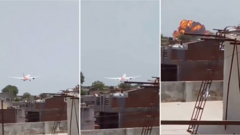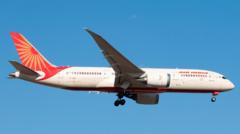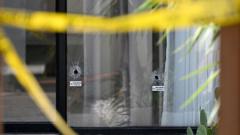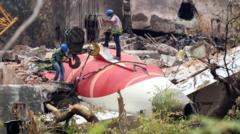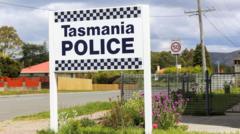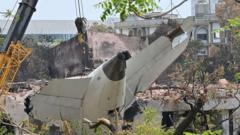Investigators are delving into the wreckage of the Air India Flight 171 crash, analyzing flight data recorders and engine conditions to determine what led to the aircraft's catastrophic failure shortly after takeoff in Ahmedabad. Various theories from mechanical failure to pilot error are being explored as investigators work within a strict 30-day report timeline.
Tracing the Threads of Tragedy: Unraveling the Air India Crash Investigation
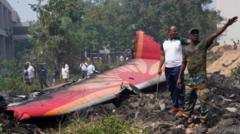
Tracing the Threads of Tragedy: Unraveling the Air India Crash Investigation
The investigation into the Air India Flight 171 crash is underway, with experts examining evidence and data to uncover the cause behind this aviation mystery.
The tragic descent of Air India Flight 171, a Boeing 787, into Ahmedabad, came just 40 seconds after take-off, leaving investigators with the daunting task of piecing together the events leading to the disaster. Following the aircraft's launch towards London Gatwick, delivering an ill-fated mayday call moments later, the investigation will rely on meticulous analysis of the aircraft debris and cockpit recordings to decipher the cause of the rapid crash.
Captain Sumeet Sabharwal and co-pilot Clive Kundar were piloting the flight carrying 242 passengers and significant fuel when the aircraft encountered a catastrophic failure post-take-off. Former Aircraft Accident Investigation Bureau investigator Captain Kishore Chinta describes this scenario as an extremely rare instance known as a controlled flight into terrain. Initial hypotheses about the crash include potential bird strikes, fuel system malfunction, or improper flap adjustments under the given flying conditions.
As part of standard investigation protocol set by the International Civil Aviation Organization (ICAO), a preliminary report on the crash will be expected within 30 days, while a full analysis may take up to a year. Investigators aim to scrutinize the aircraft's black box data—comprising cockpit audio and flight performance metrics—which may provide critical insights into engine function at the time of impact. Experts note that understanding the extent of engine power at the crash moment can significantly affect the trajectory of the investigation.
As teams retrieve the engine wreckage, examination of its condition will serve as a primary indicator of engine efficiency before the crash. Detailed inspections will extend to the cockpit variability as well, investigating each recorded element, including thrust settings, engine performance, and possible pilot actions leading up to the incident.
The investigation also spotlights fuel contamination or maintenance oversights as additional possibilities for the crash. With no initial evidence pointing to human error on Air India's side, the focus is shifting towards understanding whether this incident indicates an isolated malfunction or a larger systemic issue that could endanger the global fleet of Boeing 787s, of which there are over 1,100 in service since 2011.
The scrutiny of every detail—from the aircraft’s maintenance records to pilot training histories—will play a crucial role in determining the nature of the accident. Uncovering tangible evidence from the wreckage will be essential for a comprehensive understanding of what transpired during Flight 171. Technological advancements in recording systems offer the hope of revealing critical information that might have remained elusive in past investigations, enhancing the pathway towards aviation safety.
As the investigation unfolds, authorities and experts remain committed to drawing early conclusions while acknowledging the complexity and time-consuming nature of aviation accident analyses. Their endeavor centers not simply on finding answers but ensuring the future serenity of air travel is maintained.
Captain Sumeet Sabharwal and co-pilot Clive Kundar were piloting the flight carrying 242 passengers and significant fuel when the aircraft encountered a catastrophic failure post-take-off. Former Aircraft Accident Investigation Bureau investigator Captain Kishore Chinta describes this scenario as an extremely rare instance known as a controlled flight into terrain. Initial hypotheses about the crash include potential bird strikes, fuel system malfunction, or improper flap adjustments under the given flying conditions.
As part of standard investigation protocol set by the International Civil Aviation Organization (ICAO), a preliminary report on the crash will be expected within 30 days, while a full analysis may take up to a year. Investigators aim to scrutinize the aircraft's black box data—comprising cockpit audio and flight performance metrics—which may provide critical insights into engine function at the time of impact. Experts note that understanding the extent of engine power at the crash moment can significantly affect the trajectory of the investigation.
As teams retrieve the engine wreckage, examination of its condition will serve as a primary indicator of engine efficiency before the crash. Detailed inspections will extend to the cockpit variability as well, investigating each recorded element, including thrust settings, engine performance, and possible pilot actions leading up to the incident.
The investigation also spotlights fuel contamination or maintenance oversights as additional possibilities for the crash. With no initial evidence pointing to human error on Air India's side, the focus is shifting towards understanding whether this incident indicates an isolated malfunction or a larger systemic issue that could endanger the global fleet of Boeing 787s, of which there are over 1,100 in service since 2011.
The scrutiny of every detail—from the aircraft’s maintenance records to pilot training histories—will play a crucial role in determining the nature of the accident. Uncovering tangible evidence from the wreckage will be essential for a comprehensive understanding of what transpired during Flight 171. Technological advancements in recording systems offer the hope of revealing critical information that might have remained elusive in past investigations, enhancing the pathway towards aviation safety.
As the investigation unfolds, authorities and experts remain committed to drawing early conclusions while acknowledging the complexity and time-consuming nature of aviation accident analyses. Their endeavor centers not simply on finding answers but ensuring the future serenity of air travel is maintained.


